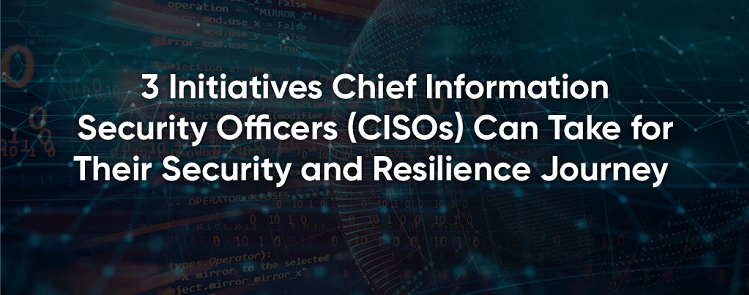Information technology is now increasingly crucial for businesses of all sizes and industries. This means that the chief information security officer (Certified CISO) plays an essential role in safeguarding organizations’ sensitive digital assets, from software applications to databases. The list of Certified CISO roles and responsibilities ranges from proactively securing the IT environment to investigating cyberattacks and other security incidents.
By adopting the right plans and taking the right steps, Certified CISOs can ensure that their company is best prepared to handle the rapidly evolving IT security landscape. This article will go over three of the most important initiatives that Certified CISOs can take on their organization’s journey to IT security and resilience.
The Importance of Securing the IT Landscape from Cyberthreats
Modern IT ecosystems include hardware devices, software applications, networks, and data, all interacting in a complicated web of relationships. They also involve the people who use the hardware, software, and data, as well as the procedures that govern that usage.
Certified CISO roles and responsibilities, therefore, must include establishing the right technologies and policies for important IT security concerns such as backups, disaster recovery, change management, and user authentication. IT environments don’t operate in a vacuum: they are constantly affected by external forces, many of them malicious. Cyberthreats such as phishing, hacking attempts, data breaches, malware, and ransomware all pose massive problems for organizations that are ill-equipped to handle these dangers.
If businesses fall victim to one of these threats, they can suffer serious financial, reputational, and even legal consequences. According to an IBM report, the average cost of a data breach for businesses is now over $4.35 million (IBM, 2022). Moreover, the report found that too many companies struggle to bolster their defenses after an attack: 83% of organizations say they have suffered multiple data breaches.
Challenges for Certified CISOs in Securing and Migrating Legacy Systems
Legacy systems pose a unique challenge for organizations and Certified CISO cybersecurity professionals. Businesses that continue to use legacy systems are at greater risk of cyber attack: the system may no longer be supported by the manufacturer or suffer from unknown or unpatched security vulnerabilities. Updating legacy systems is, therefore, one of the main Certified CISO roles and responsibilities.
However, although many companies would like to refresh their legacy IT systems, far fewer are putting this desire into practice. The challenges of securing legacy systems and migrating them to the cloud include the following:
◉ Compatibility issues that require organizations to completely rewrite an application’s codebase before integrating it with the rest of the IT environment.
◉ Lack of internal skills, preventing organizations from getting started on the migration project without the right IT modernization partner.
◉ Cost, including the expenses of purchasing new hardware and software, hiring, onboarding, and training new IT personnel.
◉ Technical complexity that has accrued over the years as the legacy system becomes more entrenched, making it harder to find security flaws or replace it with a modern version.
3 Steps Certified CISOs Can Take to Improve Security and Resilience
There are many Certified CISO roles and responsibilities, but among the most important is improving the organization’s IT security and resilience. CISOs must possess the right IT security management skills to successfully govern the business and protect it from external cyberthreats. Below are three ways for Certified CISOs to strengthen their company’s IT security and resilience.
1. Reduce the cost of a breach with cyber defense and recovery plans
Businesses can help reduce the risk of a data breach by creating the right cyber defense and recovery plans. This comprehensive strategy should include the following:
◉ A risk assessment of the IT environment’s threat landscape
◉ An incident response plan that defines in detail the procedures to follow after a breach.
◉ A business continuity plan that outlines how to recover from a breach as quickly and gracefully as possible.
2. Define a zero-trust strategy aligned with governance and compliance
According to the U.S. Department of Defense, “zero trust” means that organizations should “never trust, always verify” (DOD CIO, 2022). Rather than granting indiscriminate access to applications, devices, and other IT assets, businesses should give users only the resources they need when they need them.
In a zero-trust approach, all users, devices, and applications are treated as potentially compromised, with the organization’s defenses locked down accordingly. Techniques may include strict access controls, multifactor authentication (MFA), and monitoring user activities. Certified CISOs should act to define a zero-trust strategy that aligns with the organization’s IT governance and compliance requirements.
3. Protect legacy and hybrid systems
Legacy systems (and hybrid systems that combine modernized and legacy tech) can pose substantial cybersecurity risks — but this doesn’t mean that CISOs are helpless. If the business plans to continue its use of legacy or hybrid technology for the foreseeable future, Certified CISOs can take steps such as:
◉ Mapping critical legacy IT assets and thoroughly assessing the risks and vulnerabilities.
◉ Implementing alternative security measures such as intrusion detection systems (IDS) and access controls
◉ Walling off legacy systems from the rest of the IT environment to halt the motion of attackers.
Source: eccouncil.org





0 comments:
Post a Comment